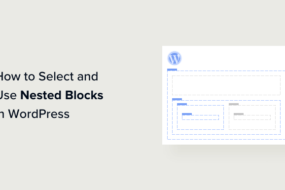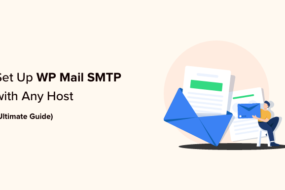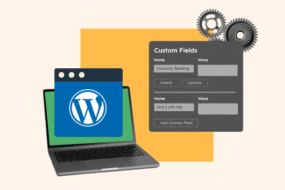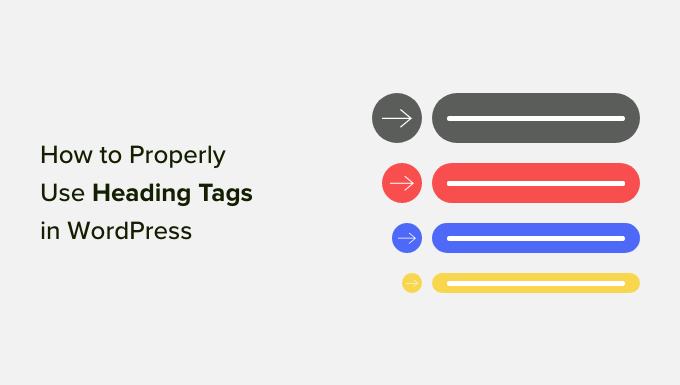
Are you wondering how to use H1-H6 heading tags in WordPress?
Using headings effectively in your posts and pages makes your content more readable, improves user experience, and boosts your website’s SEO.
In this article, we’ll show you how to properly use heading tags in WordPress.
What Are Heading Tags in WordPress?
Heading tags are HTML elements used to identify the title and headings on a webpage.
Both visitors and search engines will understand your content better when your posts and pages contain headings. When you add headers correctly, you can improve the post’s SEO to rank higher on search engine results pages (SERPs).
You add a logical structure to your posts by using different heading levels. Post titles will use H1 tags; you typically use H2 tags for the main headings and H3 tags for subheadings.
When viewing a webpage as HTML, heading tags look like this:
Post Title
Heading
Subheading
And so on
However, you can easily add heading tags to your WordPress posts and pages without using code.
We cover this step-by-step in our guide on changing the font size in WordPress.
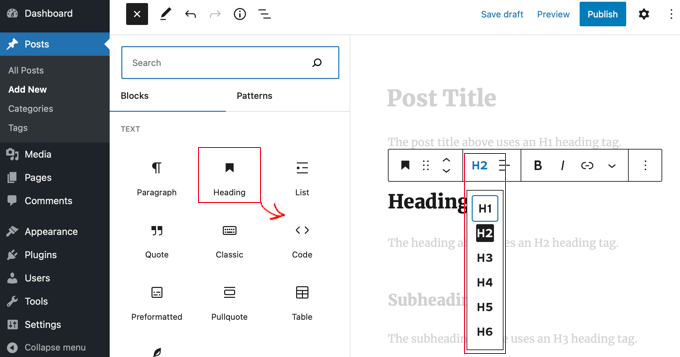
Your theme’s stylesheet controls the sizes and colors of the different heading styles, and we’ll show you how to customize their appearance below.
Let’s look at using H1-H6 heading tags in WordPress properly. Here is a quick overview of what we’ll coverwe’llhis guide:
- Use Headings and Subheadings to Structure Your Content
- Customize the Appearance of Headings to Grab Attention
- Use Headings to Improve Readability and User Experience
- Optimize Your Headings for SEO by Adding Appropriate Keywords
- Automatically Create a Table of Contents From Headings
- Optimize Headings to Rank for Google Featured Snippets
- FAQ: Frequently Asked Questions About Heading Tags in WordPress
1. Use Headings and Subheadings to Structure Your Content
Headings help you create a logical structure for a post or page. They guide your readers through the article by briefly describing the main sections of the topic and how they relate to one another.
You can use up to six hierarchical heading levels to structure your content:
- H1 tags are the most important, and a post should have only one H1 heading. This tag is used for the post title, and you can learn how to add and optimize your titles in our guide on SEO titles and H1 post titles in WordPress.
- H2 headings are the main headings used in a post’s diffpost’ssections. If you need to split these sections into subsections, you can use H3 tags. Most themes will display H3 subheadings in a smaller font than H2 headings.
- Most posts only need two or three levels of headings, so you may never use heading tags H4 to H6 on your WordPress website. However, they can be used to provide further structure in very long posts or academic articles.
Structuring your posts in this way helps website visitors and search engine crawlers quickly grasp the context of your content. A well-structured post may be ranked higher on search engine results pages.
Tip: Make sure you use heading tags to structure your article and not simply for formatting, such as making a block of text larger. For more on formatting text, see our guide on quickly changing the font size in WordPress.
2. Customize the Appearance of Headings to Grab Attention
Using headings in your content is a great way to grab user attention with a larger-size font. In most WordPress themes, titles are in a larger font than the regular body text, allowing you to break your posts and pages into sections.
You can also customize the appearance of your headings so they stand out even more. For example, adding color, especially with H1, H2, and H3 tags, can attract attention to your titles.
Some themes offer preset font choices that will change your website fwebsite’sdes; you can also change fonts for individual elements on your piece. For example, you can use a different font for the body text and headings, and there are even options to use separate fonts for each Heading level.
For more details, see our guide on changing fonts in your WordPress theme.
3. Use Headings to Improve Readability and User Experience
No one likes a wall of text. The easiest way to make your content more readable is by breaking it up using headings and short paragraphs.
This makes it easier to read and understand your content. It also helps your users quickly scan the article and find the sections they want to read more thoroughly.
These factors will increase page views and reduce bounce rate, which is good for SEO.
Checking the Readability of Your Headings Using All-in-One SEO
The best way to prevent the readability of your post is by using All in One SEO (AIOSEO). The best WordPress SEO plugin allows you to easily optimize your WordPress website for search engines and social media platforms.
Note: The free version of AIOSEO will show you if your post contains enough headings and also let you set a focus keyphrase, as we cover below. However, the extra features of the premium version will get your site ranking even higher on search engines.
Once you have installed and configured All in One SEO, scroll below the post content to the AIOSEO General Settings area.
You will find a ‘Page Analy’is’ section that lists actionable tasks you can follow to make the post rank higher. It includes tabs for ‘Basic SEO,’ ‘Title,’ ‘n,’ ‘Read’bilit,’’ and each ‘ab shows how many errors you need to fix in that category.
The ‘Readability’’ tab offers’ suggestions on improving readability, including images, shortening paragraphs and sentences, using transition words, adding subheadings, and more. Items marked with a red cross need more work.

Under ’Subheadin’ distribution,’ you will ‘e given feedback on any steps you need to take to improve the headings in the post, such as:
- ‘1 section ‘f your text is longer than 300 words and is not separated by subheadings. Add subheadings to improve readability.’
- ‘You are ‘o’ using any subheadings, but your text is short enough and probably doesn’t needles not.
- ‘Great Jo’!’
It would ‘e best if you aimed to get a green checkmark next to every item under the Page Analysis section to improve the post’s SEO. post’stimize Your Headings for SEO by Adding Appropriate Keywords
Adding headings to your blog posts is great for your site’s SEO.site’ss becaThat’sarch engines give titles more weight than standard paragraph text, and Google will try to use the content of your headings to understand better the topic you are writing about.
You can optimize your headings for SEO by adding appropriate keywords. These are the keywords users will search for when looking for your content, and you can learn how to find them in our guide on keyword research for your WordPress blog.
But you mustn’t. It’s just addon’tandom keywords to your headings, and only use keywords when they make sense and clearly describe what that part of the post is about.
Checking Whether Your Headings are SEO Optimized Using All-in-One SEO
You can use All in One SEO‘s SEO ASEO’sis feature to check whether you have used enough keywords in your headings.
First, you need to add a focus keyword to your post. Scroll to AIOSEO Settings under the post content, then type the post’s mostpost’stant keyword next to ‘Focus Keyp’rase.’

The plugin will then analyze your content for the keyword, show you a score, and suggest how to improve your ranking.
Among other things, All in One SEO will show you if your post has a healthy number of keyword-optimized H2 and H3 subheadings.
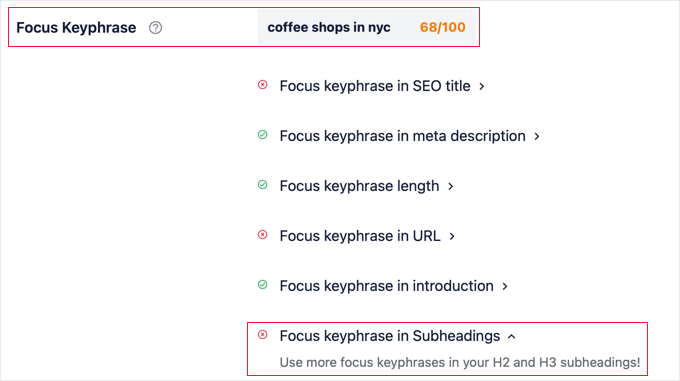
You can also use All in One SEO to optimize the post title. For more details, see our guide on using a headline analyzer in WordPress to improve SEO titles.
Besides adding keywords, we also recommend making your headline catchy and click-worthy. Your organic click-through rate (CTR) is essential in SEO.
5. Automatically Create a Table of Contents From Headings
A table of contents is a clickable list of the headings in a post. They make jumping between the sections of a long article easier, improving navigation through your content.
When visitors click a link in the table of contents, they will be taken immediately to that heading in the article. This allows users to move to the content they are interested in quickly.

All-in-One SEO can save you time by automatically generating the table of contents based on your subheadings and making it customizable with editable links.
When editing your post, you’ll needyou’llick the blue ‘+ ’ icon and advocate the ‘AIOSEO – Table of Contents’ bContents’ag the block onto the post or page where you wish the table of contents to appear.
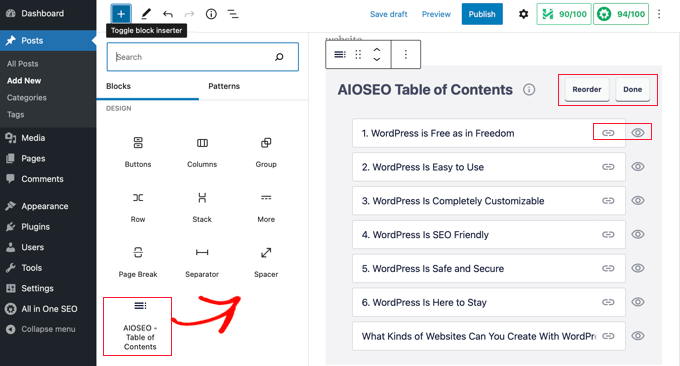
The plugin will automatically identify the headings on the page and add them to your table of contents. If you use different Heading levels (say H2 and H3), lower-level titles will be indented to show the structure of your content.
If you are still writing the contents of your post or page, any headings added to the document will be automatically added to the table of contents. Also, any changes you make to the titles will be reflected in the ToC block.
For step-by-step instructions, see our guide on creating a table of contents in WordPress posts and pages.
6. Optimize Headings to Rank for Google Featured Snippets
Organizing your heading tags well may help your content rank for Google featured snippets. These are highlighted results shown at the top of the search results page.
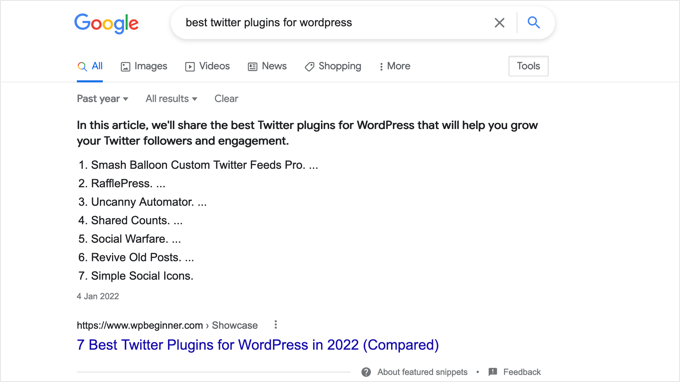
Google pulled the headings from the above post to create the number list on the search results page, earning this post a featured snippet.
This will help you get the maximum SEO traffic since a user is likelier to click on a featured snippet than a direct search result.
For tips on ranking for featured snippets, see our guide on how to get a Google Featured Snippet with your WordPress website.
FAQ: Frequently Asked Questions About Heading Tags in WordPress
Here are some of our readers most common questions about heading tags.
What is the difference between H1 and H2 in WordPress?
H1 is used for the post title; this should be the only H1 heading in a post. H2 is used for the main headings throughout a post. H1 and H2 are the only Heading tags you will need for many blog posts.
What are the six types of headings in WordPress?
There are six types of heading tags in WordPress, and they are H1, H2, H3, H4, H5, and H6. The H1 tag is used for the title, and H2-H6 can be used for different headings and subheadings throughout the post.
You don’t need to don’t all six levels of headings in a post. However, it would be best if you didn’t skip shouldn’t. For example, when you use H2 for titles, you should use H3 for subheadings and not skip straight to H4.
What is the difference between H1 and TITLE in WordPress?
The title you type at the top of a post or page is an H1 heading. However, when search engines display the post in search results, they will use a different title identified by a TITLE tag rather than H1. This is known as the SEO title or meta title.
You can add a meta title to your post using an SEO plugin such as All in One SEO. You can learn more in our guide on the difference between SEO and H1 post titles in WordPress.
How do I create an H1 heading in WordPress?
When you create a new post or page in WordPress, you will see the words ‘Add title at the top of the page. Type the post title on this line to add an H1 heading.
While creating additional H1 headings using Heading blocks is possible, we don’t recomdon’tusing more than one H1 tag.
How many H2 headings should a WordPress post have?
H2 headings are used to break up a long post and make it more readable, and there are no rules about how many you should use. If your post is only a few paragraphs long, you may not need to add H2 headings.
The All in One SEO plugin has a Page Analysis feature to check your blog post for readability. In general, if you have 300 words of text or more without a heading, it will recommend adding more headings or subheadings.
Do heading tags affect your WordPress website Swebsite’sthe title of your blog post is significant for search engine optimization (SEO). A powerful title can get people to click on the link to visit your website, so we recommend you use a headline analyzer to create engaging titles that get more clicks.
H2-H6 headings can also impact SEO, and they improve user experience, and this improves SEO. Adding appropriate keywords to your headers may also help your post rank higher.
We hope this tutorial helped you learn how to use H1-H6 heading tags in WordPress properly. You may also want our guide on creating an email newsletter or our expert picks on the best SEO plugins and tools.



